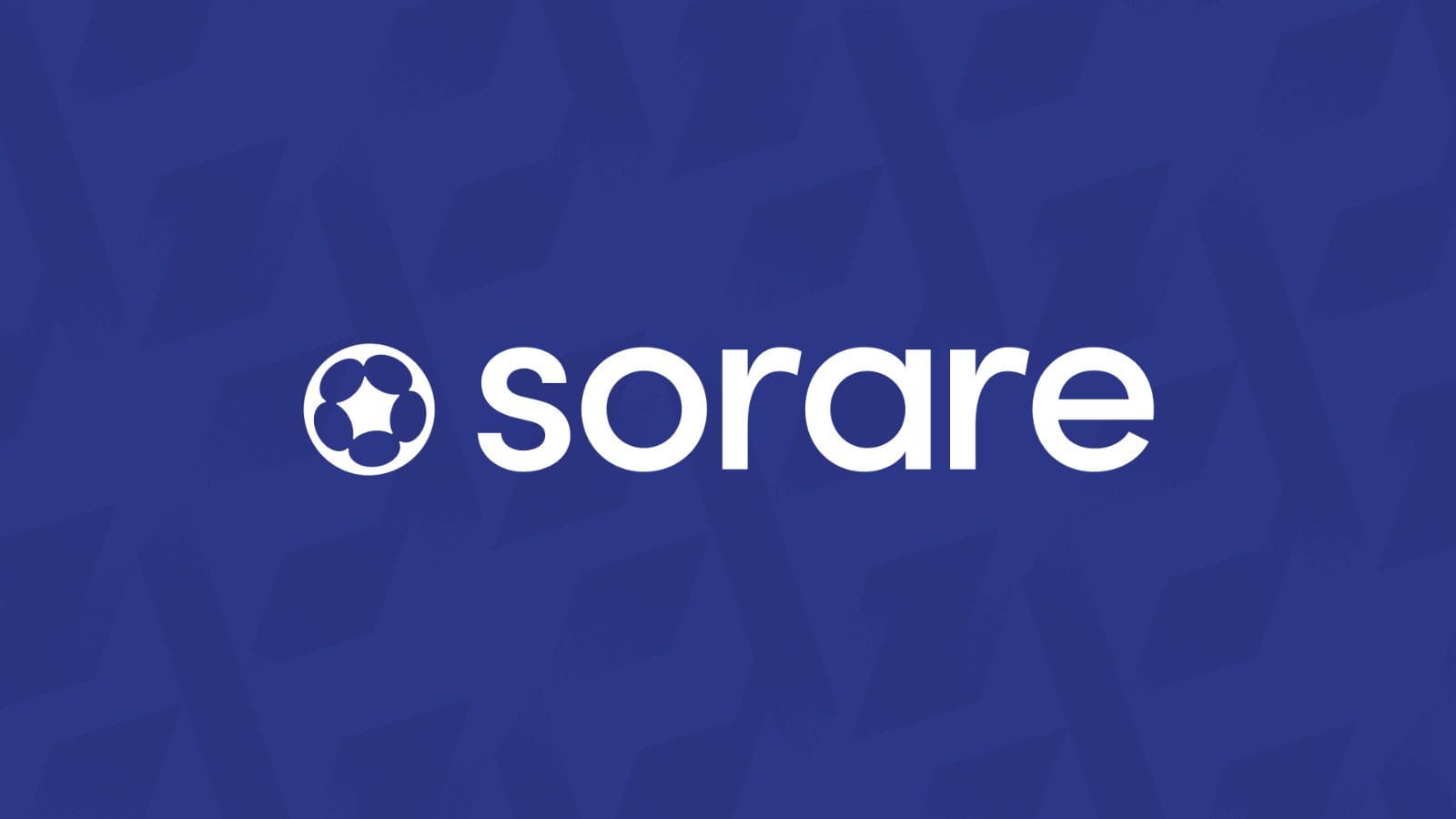What is Sorare?
Sorare is a fantasy sports gaming platform. Founded in 2018 by Adrien Montfort and Nicolas Julia, the company promises to transform the concepts of gaming and ownership of in-game-assets as we know them.
Leaning on Ethereum’s blockchain technology, Sorare allows its users to have actual ownership of the assets that are purchased on it. In fact, Sorare cards sold are NFTs minted (minted) on the blockchain.
Each trainer is assigned a wallet, within which the cards, whether won or purchased, are deposited in the form of NFTs.
The Ethereum infrastructure allows them to be traded or sold at any time, giving users the ability to dispose of them freely, including by withdrawing them on an external wallet.
Herein lies the main difference with the current mainstream gaming paradigm, where in-game purchases are generally not convertible back into currency or exchangeable with other users. Moreover, the utility of the purchased asset is usually limited to the game ecosystem itself, as is any virtual currency used as a medium of exchange on the internal marketplace.
Despite this, the numbers in the gaming industry are growing steadily. In-game purchases represent a major source of revenue for most of the big players in the industry.
Whether it is for “cosmetic” improvements or upgrades that provide better performance and faster progression, many gamers choose to make in-game purchases, often in exchange for the ability to enjoy the game for free.
Alongside the actual ownership of assets, Sorare offers a wide range of tournaments with prizes up for grabs in the form of cards and ETH, where managers compete with their own lineup. This makes Sorare cards yield-bearing assets, that is, assets whose effective return is determined not only by the increase or decrease in value but also by the cashflows they generate .
Fantasy football‘s scoring system is also revamped: player scores are in fact determined by a comprehensive set of about 50 different statistics collected live during games.
In this introductory article we will focus on the platform’s original and longest-running product, SorareFootball. However, what is described in the next paragraphs also applies with similar logic to the two new products launched during 2022, SorareNBA and SorareMLB.
If you’re super curious, you can already check them out here (and thanks to this bonus link, get a free limited card when you buy 5 cards of any type).
Index
Sorare Cards
Let’s start the guide by talking about the asset on which everything revolves: the Sorare cards.
NFT Sorare cards are divided into four different scarcities: limited (yellow), rare (red), super rare (blue) and unique (black).
The term “scarcity” refers to the maximum number of mintable cards per sports season. In fact, a maximum of 1000 limited cards, 100 rare cards, 10 super rare cards, and 1 unique card can be mined per player each year. Since there is no minimum minting limit, Sorare will be able to create less than the maximum amount.
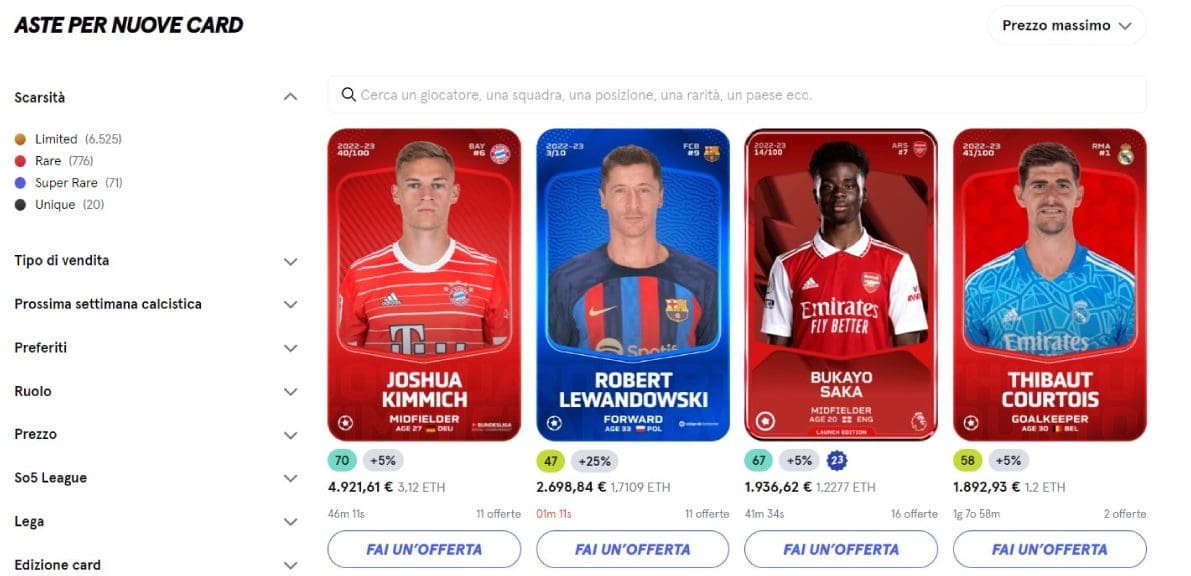
About 50% of the annual supply is sold by Sorare through auctions during the season; 40% is distributed as prizes during tournaments, while the remaining 10% is used for promotional purposes.
To date, Sorare Football has partnerships with 316 clubs, while SorareMLB and SorareNBA own the official licenses of their respective leagues.
In addition to the scarcities mentioned above, there is also a category called “common” (white), used in the free-to-play version of the game. This group has an unlimited circulation; therefore, it is not tradable on the secondary market.
During the process of onboarding to the platform, each user will have the opportunity to select their own common cards, with which they can participate in free-to-play competitions.
The scarcity of cards determines the type of tournaments in which they can be used. As we will see later, tournament prize pools vary significantly depending on the scarcity of eligible cards.
In addition, in mixed tournaments, competitions in which cards of two different categories can be fielded, cards of lower scarcity will benefit from an additional 20 percent bonus on the player’s final score.
Regardless of the run, all Sorare cards accumulate experience points with use in competitions and training teams.
Experience point advancement is measured in 20 levels; the first few are attainable after a few days/weeks of use but reaching level 20 requires approximately two seasons of constant use. At each subsequent level, the card will gain an additional 0.5 percent bonus on its final scores. Thus, an xp bonus of 0% will apply to a level 0 card, a level 6 card of 3%, and a level 20 card of 10%.
Importantly, whenever a card is traded or sold to another manager, the xp points accumulated up to that point are halved.
Cards can accumulate between 200 and 400 xp points each week, and level 20 is reached at 24,500 points. This factor is a not insignificant incentive for holding cards over the medium to long term in order to increase one’s competitiveness in tournaments.
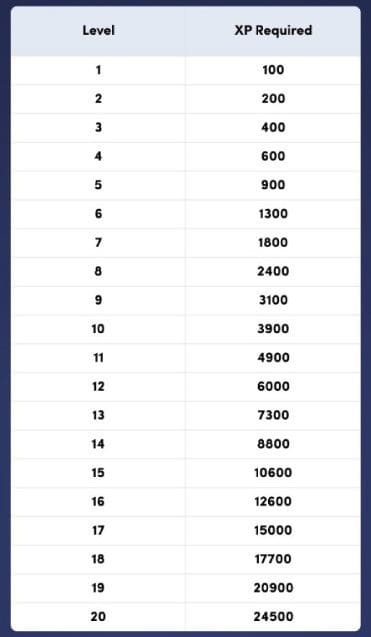
Sorare Scoring Matrix
So how is a player’s score calculated? The final score is the result of the algebraic sum of two separate components, the decisive score and the all-around score; it can vary between 0 and 100 points.
DS: Decisive score
The decisive score (DS) gives the player bonuses or maluses for plays that produce a direct impact on the outcome of the game.
Goal, assist, penalty procured, line save, last man tackle, penalty saved (for goalkeepers only), clean sheet (for goalkeepers only) are the positive decisives.
Conversely, negative decisives represent plays that penalize one’s team: red cards, own goal, penalty caused, error leading to a goal, 3 or more goals conceded (for goalkeepers only).
The starting DS of each player deployed as a starter at the beginning of the game is 35 points (25 for substitutes entering the game in progress).
The player’s first positive decisive will bring the DS to 60 points, while the first negative decisive will bring the DS to 15 points. For each subsequent positive or negative decisive awarded to the player, the DS will increase or decrease by an additional 10 points.
Players who do not take the field during the match receive a score of 0 points; therefore, it is critical to try to select five players who will play the match as starters.
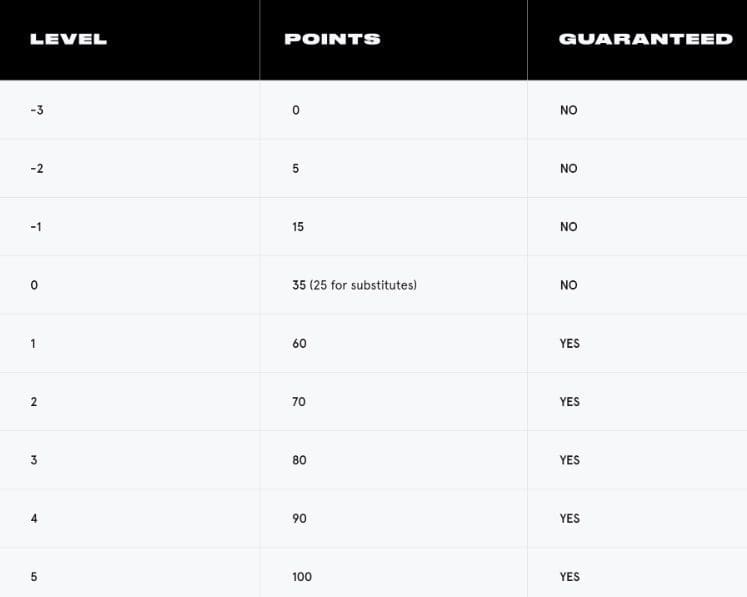
A few examples:
- A player who scores a goal will get a DS of 60 points
- A player who scores an own goal will get a DS of 15 points
- A player who scores a goal and an own goal will get a DS of 35 points
- A player who scores two goals will get a DS of 70 points
- A player who scores an own goal and receives a red card will get a DS of 5 points
- A player who scores two goals and provides an assist will get a DS of 80 points
AAS: All-around scoring
Turning to the all-around score (AAS), it can take positive or negative value. If positive, it is always added to the DS to determine the final score; if negative, it is subtracted from the DS only in cases where the DS is 35 points or less.
The all-around score reflects statistics of secondary importance, with less relevance than decisive actions, but still influential on the course of the match.
In total, there are 40 different statistics that make up the all-around score. Each of these is assigned a positive or negative value, leading to an increase or decrease in the player’s all-around score each time a statistic is noted during the match. Here you will find the complete list of detected statistics and the values assigned to each.
A player’s all-around score is then calculated as follows:
(Decisive score +/- all-around score) * bonus xp
The total team score is calculated by adding up the scores of the individual players. One of the five fielded players must also be selected as captain, which will give him an additional 20 percent bonus.
Sorare Football Tournaments
The range of Sorare competitions in which to use one’s cards is quite extensive.
The cadence of the tournaments is biweekly. The weekend round starts at 4 p.m. on Friday and ends at 4 p.m. the following Tuesday; the midweek round opens at 4 p.m. on Tuesday and closes at 4 p.m. on Friday of the same week. All players who play a match within the time frame of a round may be fielded in the competitions of that round.
Tournaments are divided into two main categories: capped competitions and regional competitions.
Capped competitions
In these Sorare leagues, managers must select five players whose average Sorare score over the last 15 games is below a certain threshold.
Neither the xp bonus nor the captain bonus is applied to the players’ base score. Players playing in any league can be fielded.
Currently, three capped competitions are available: cap 220 (sum of the averages of the five players’ scores in the last 15 games equal to or below 220), cap 240 and cap 270.
Prizes in the form of Sorare cards are offered in each of these three competitions . Value and desirability of the rewards vary depending on placement in the final standings, which are compiled based on the total score of the deployed team.
The percentage of participating managers rewarded with a card varies depending on the competition, usually ranging from 10 to 20 percent (however, there is no guaranteed minimum).
The cap 240 competition puts up a predetermined prize in ETH for each line-up that scores 250 points or more.
Cap 240 competition is the starting point for many managers approaching the platform. This is because the payouts are generally more predictable and consistent than in competitions whose prize pool consists of cards only.
The particularity of capped competitions lies in the fact that managers compete on a level playing field. In fact, all participants must select five players whose recent performance level is below the same threshold.
Regional competitions
These Sorare tournaments have no entry requirements related to the recent performance of the players to be fielded. However, each one does require that a specific “geographic” requirement be met. Below is a list of all regional competitions and a description of their eligibility criteria:
- All-Star-Rare: selectable players playing in any league;
- Under-23: selectable players under 23 years of age as of June 30 of the current season;
- Champion Europe: selectable players militant in any of the 5 major European leagues;
- Challenger Europe: selectable players militating in a top European minor league;
- Second Division Europe: selectable players militating in a European second division league;
- Champion America: selectable players militating in a league on the American continent;
- Champion Asia: selectable players playing in a league on the Asian continent.
The geographical eligibility criterion also determines the composition of the prize pool; in fact, the cards distributed as rewards in each regional tournament will belong to one of the leagues eligible for the competition itself. All regional tournaments distribute Ether prizes to the three managers who place on the podium.
Unlike capped competitions, where the cards fielded must all be of identical scarcity, some divisions of the regional tournaments allow for the possibility of fielding cards of different scarcities in the same lineup. Let’s look at them in more detail:
- Limited division: 5 limited cards
- Rare division: 5 rare cards
- Rare pro division: min 3 rare cards, max 2 super rare cards (ex: 4 rare + 1 super rare, 3 rare + 2 super rare, 5 rare)
- Super rare division: min 3 super rare cards, max 2 unique cards
- Unique division: min 3 unique cards, completable with super rare
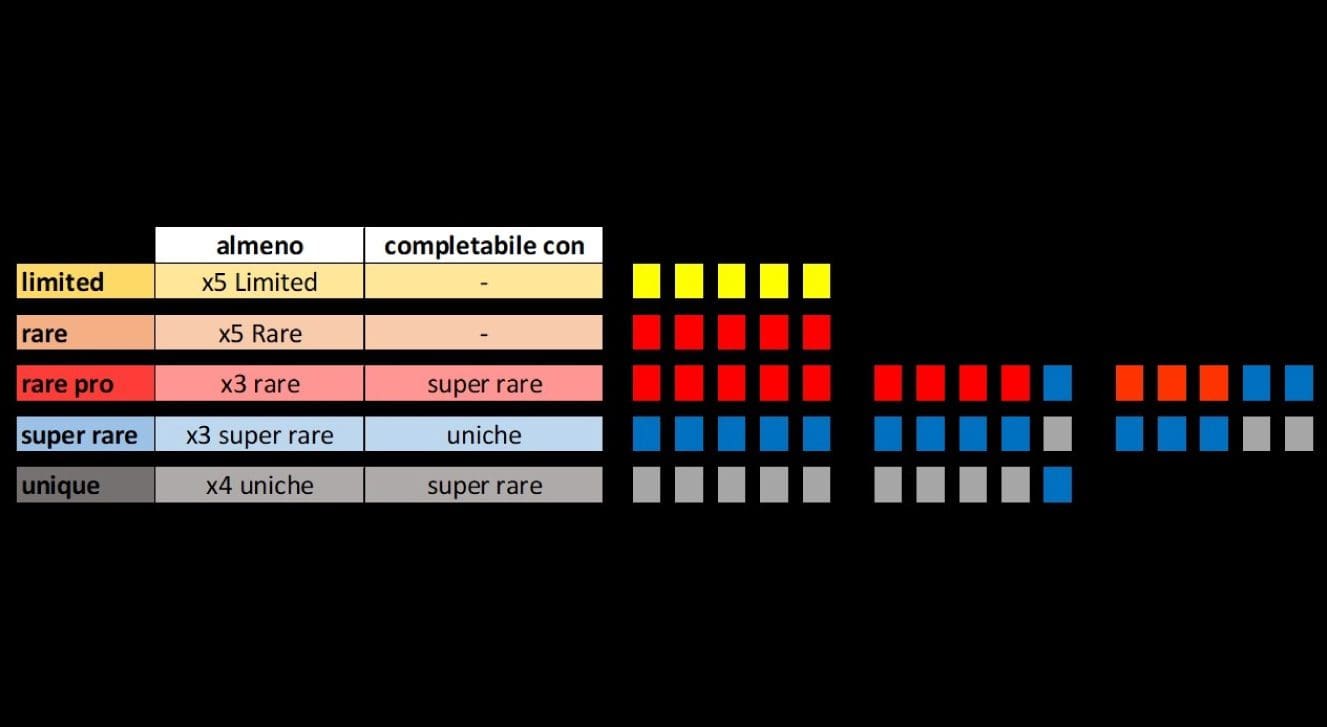
For each of these divisions, it will be possible to participate in one of the regional competitions listed above. In mixed scarcity divisions, cards of higher scarcity get an additional 20% bonus on their base score.
In all regional competitions, both the xp and captain bonuses are applied to the player’s score, and in addition to the cards, eth prizes are offered for the three managers who finish on the podium.
Strategies: how do you play on Sorare?
There are many possible approaches to the game, and each manager can choose the one that suits him or her best, depending on the time and budget available, as well as his or her personal skills and preferences.
Let’s find out how to get around and, most importantly, answer the question “how do you make money on Sorare?”
So5 approach
This game strategy consists of composing a roster of Sorare players to be deployed in weekly competitions. The goal is to earn rewards to strengthen one’s team or produce as regular an income as possible.
Knowledge of one’s chosen sport is a fundamental added value for those competing in weekly tournaments. Staying informed about the status of one’s players helps to avoid fielding injured or disqualified players; following matches allows one to evaluate their performance more effectively.
Knowledge of opposing teams allows one to choose players to field based on how favorable their matchups are.
Statistical analysis of the performance of one’s players (and potential players to add to the roster) is an excellent alternative or supplementary tool to direct observation of performance. When coupled with a constant reassessment of the player’s current situation (hierarchies in the team, competitiveness of the team and league to which they belong, etc.), aimed at estimating the predictive value of historical data, it can prove to be of great help to all users with time constraints that do not allow direct performance monitoring.
Budget requirements vary significantly depending on the scarcity chosen and the manager’s ability to select undervalued players or players with future potential not yet priced by the market. Therefore, the budget “requirements” below are only indicative.
So, how much does Sorare cost?
Currently, a manager who decides to purchase cards of limited scarcity will be able to compose a fairly competitive team with a budget in the range of tens/few hundred euros.
Rare scarcity requires a larger initial investment: in fact, the average ratio between the price of a player’s rare card and its limited counterpart is about 9:1.
The extreme illiquidity of the Super Rare and Unique card markets makes it more complex to reliably estimate the budget needed to build a lineup that can at least compete for prizes in the form of eth. Approximately, the capital needed is between 5 and 20 times that required for rare scarcity, depending on the scarcity chosen.
Trader Approach
This Sorare game strategy consists of trying to make a profit from buying and selling players. The determinants of a kicker’s market value are easily identified and monitored; therefore, it is possible to predict without too much difficulty the direction of price change as one of them changes.
For example, the cards of a kicker who is injured for a long period of time or who is coming off a series of negative performances will likely go down in value.
Below is a non-exhaustive list of circumstances in which buying a player may prove profitable with a view to resale in the short to medium term:
- Upcoming favorable matchups (greater likelihood of overperforming one’s averages);
- Imminent increase in minutes (due to better performance or injury/disqualification of teammates);
- Potential favorable transfer (more minutes and/or better expected performance);
- Recent underperformance of historical averages not caused by external factors;
- Upcoming return from injury (the longer the wait time, the greater the discount on the player’s fair price);
- Championship on hiatus (having no matches to be played, the cards of players whose season is not underway cannot be used in tournaments, which historically has led to a significant decrease in prices).
The ability to buy players at favorable times must be coupled by the trader with the ability to resell at the right time. Indeed, the extreme volatility of prices, particularly in the Limited market, can sometimes result in a rapid retrenchment of unrealized profits.
This type of approach does not require a minimum budget, as it is possible to buy cards as low as a few cents in price. The capital available will, of course, determine the caliber and scarcity of exchangeable players; in any case, being able to have higher funds will not bring any advantage in relative terms.
Scout Approach
The goal of users adopting this strategy is to identify players with future potential in order to buy them at affordable prices and use them in their formations or resell them once that potential has materialized.
Low minutes and inconsistent ownership significantly impact the price of a footballer, as these factors significantly diminish his usefulness in Sorare competitions.
For this reason, the attention of scouts is very often focused on young players whose qualities are still fully or partly unexpressed or whose entitlement is hampered by the presence of more established teammates.
Back-up goalkeepers are also often the subject of scouts’ purchases, since a change in hierarchies within the team or a transfer that would ensure their ownership would result in a substantial increase in their value.
Like the Trader approach, the Scout approach does not require minimum budget thresholds. The two methods are certainly similar and somewhat overlapping, but the Scout user will generally have a longer resale time horizon than the Trader user.
Sorare crypto: trivia and conclusions
Let’s close this introductory guide with some trivia related to this platform.
First of all, how many members does Sorare have? At December 2022, Sorare had over 3 million registered users. Of these, more than 260,000 were active monthly. They came from almost all over the world (180 different states).
Among these users, about 35,000 owned 25 or more Sorare cards of at least Limited category.
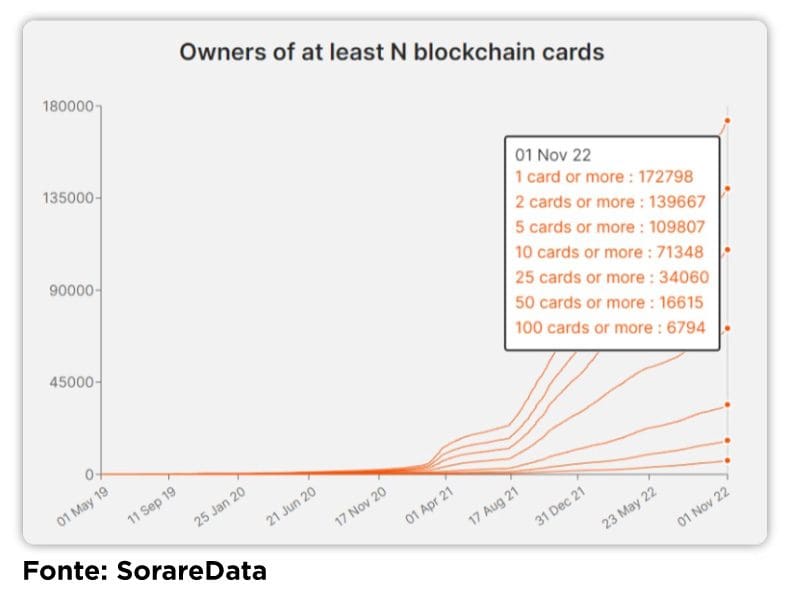
The steadily growing numbers in terms of players add up to consistently attractive volumes.
The platform is available from a computer or on mobile, via the Sorare app for Android and iOS devices.
Have we succeeded in intriguing you? Would you like to try your hand at entering the world of Sorare? Use The Crypto Gateway referral and take advantage of our bonuses!

